Low Calorie Dip Market Research, 2031
The global Low Calorie Dip Market Size was valued at $252.9 million in 2021, and is projected to reach $424.6 million by 2031, growing at a CAGR of 5.5% from 2022 to 2031.
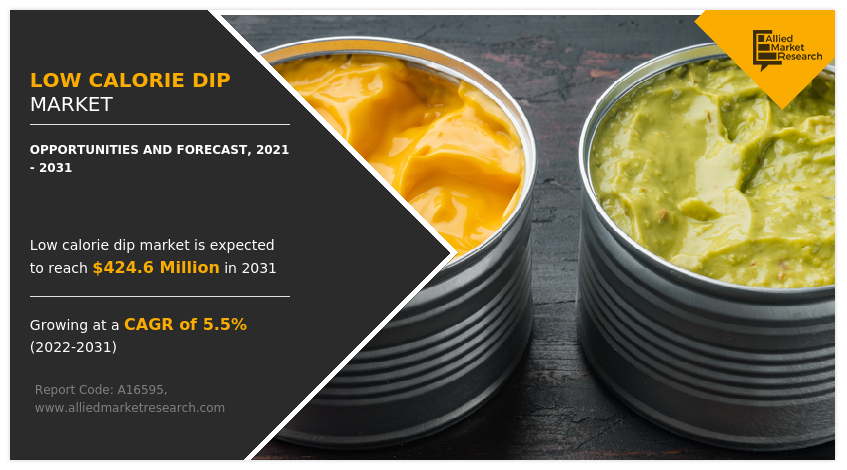
Over the past few years, there has been a significant rise in the prevalence of diseases linked to obesity, such as diabetes and cardiovascular illnesses. The Organization for Economic Co-operation and Development (OECD) reports that obesity rates are high in the U.S., Mexico, and England right now, and that by 2031, those numbers will rise to 47%, 39%, and 35%, respectively. Consumers in high-income geographic areas like North America and Western Europe are more anticipated to develop diabetes, cancer, and other serious health problems, due to their bad eating and lifestyle choices. Increased awareness of health and fitness among consumers is a result of an increase in the prevalence of these health conditions. Vegetarian or low-fat food consumption is on steadily rising over the world.
Recent research by the Organization for Economic Co-operation and Development show that 30% of Americans not only avoid eating meat, but also look for low-fat or plant-based food substitutes. It is anticipated that consumers may choose their food more carefully in order to prevent serious health problems. As a result, there is an increase in Low Calorie Dip Market Demand due to increased awareness of a healthy diet. The factors such as consumer preference for healthier low calorie products, change in culture & lifestyle of the emerging Asian Low Calorie Dip Market, and increase in demand for convenience food are impacting the Low Calorie Dip Market Growth. Moreover, the market is expected to grow at a faster rate during the Low Calorie Dip Market Forecast period, due to increase in population, rise in urbanization, and introduction of healthier bakery alternatives at reasonable costs.
Supermarkets and hypermarkets will remain the main sales channels for sweet and savory dips for the near future. However, as a newly emerging retail channel that is seeing rapid growth, internet retailing is predicted to play a more key role than before. As a result of brand-building efforts and the establishment of logistics systems, key business-to-consumer online retailers such as Yihaodian and Tmall have become more popular among domestic consumers. Moreover, internet retailing provides consumers in lower-tier cities with easier access to newly launched sweet and savory dips. The greatest potential threat to the growth of sweet and savory dips will be concern of the consumers regarding food safety.
Processed food is any food that has undergone preparational alterations to enhance its flavor, and shelf life. There are many levels of processing applied to several types of food. Even while pre-cut green beans or a packaged salad are technically processed, their natural form has not been changed, therefore the amount of processing is minimal. In other words, it closely mimics nature in appearance. On the contrary, due to the addition of artificial flavors, additives, and other ingredients, a box of mac and cheese or a microwaveable meal are considered to be extensively processed (also known as ultra-processed). The bulk of food that individuals eat have been processed in some way before they reach our plates. The debate about processed food does not, however, center on goods like canned tuna or tomatoes that have been processed to maintain their freshness and nutritional value. The expansion of the Low Calorie Dip Industry is thus being hampered by growth in consumer knowledge of the negative consequences of processed food.
Organic is one of the trending markets which is common in every food and beverage product. As consumers are becoming health conscious and are aware regarding the unhealthy production and cultivation of food crops and its effect over the body, there is also a rise in demand for organic products in the Low Calorie Dip Market. For instance, benefits associated with organic products include no usage of harmful chemicals, fertilizers GMO ingredients, pesticides, radiation, or genetic engineering. In addition, according to The Research Institute of Organic Agriculture the global revenue generated from organic market in 2019 was $123 million with 3.1 million of producers of organic agriculture worldwide. Furthermore, Australia has the largest organic agricultural land of 35.7 billion hectares and Europe had 16.5 million hectares which is equivalent to more than 60% of the global organic area followed by Latin America and Asia with 11% and 5.9%. Organic agriculture worldwide has further estimated that globally 1.5% of the farmland is organic there is a growth in this Low Calorie Dip Market Share, owing to the rise in demand for organic products.
Moreover, many consumers have negative perceptions regarding genetically modified organisms, despite endorsements from leading, global scientific organizations and more than three fourth of consumers globally think non-GMO food products are either or a lot healthier. GMOs rank remains in the top list of food concerns among the global shoppers. The key players are also stepping forward to introduce organic products in order to fulfil the increase in demand. In addition, rise in spending on organic products & and increase in disposable income, especially in the developing countries, including China, India, Brazil, and Mexico are expected to propel the growth of the organic products market, which will propel the Low Calorie Dip Industry growth in the process.
Furthermore, there is high Low Calorie Dip Market Growth in malls and the multiplex sector during entertainment time and increase in expenditure of people on food items drive the growth of the low calorie dip market. Moreover, growth of retail network especially in the emerging economies and increase in consumption of convenience goods drive the dips market growth. However, the prohibitive cost of production hampers the widespread adoption and acts as the major restraint for the global low calorie dip market.
On the contrary, rise in disposable income and increase in willingness of people on buying premium and environment-friendly products in emerging nations are expected to provide opportunities for the Low Calorie Dip Market growth in the coming years.The consumer food & beverage industry witnessed high demand for household food products during the worldwide pandemic emergency and the uncertain lock-down across the globe. A leading manufacturer in the industry is faced with low consumption of its products in the market, due to the closure of supermarkets and other stores and supply chain challenges. The companies focus more on modifying their distributional channel system to strengthen the online platform and delivery service.
The low calorie dip market is segmented on the basis of form, type, end user, distribution channel, and region. On the basis of type, the market is categorized as classic, garlic, onion, cheese, and others. On the basis of form, the Low Calorie Dip Market is bifurcated into organic and conventional. On the basis of end user, it is bifurcated into food service and residential. On the basis of distribution channel, it is divided into hypermarkets/supermarkets, specialty stores, e-commerce, and business to business. On the basis of region, it is analyzed across North America (the U.S., Canada, and Mexico), Europe (the UK, Germany, France, Italy, Spain, Russia, Sweden, the Netherlands, Denmark, Poland, and Rest of Europe), Asia-Pacific (China, India, Japan, Australia, South Korea, Thailand, Singapore, Indonesia, New Zealand, and Rest of Asia-Pacific), and LAMEA (Brazil, Argentina, South Africa, the Middle East, Saudi Arabia, Egypt, Nigeria, and rest of LAMEA).
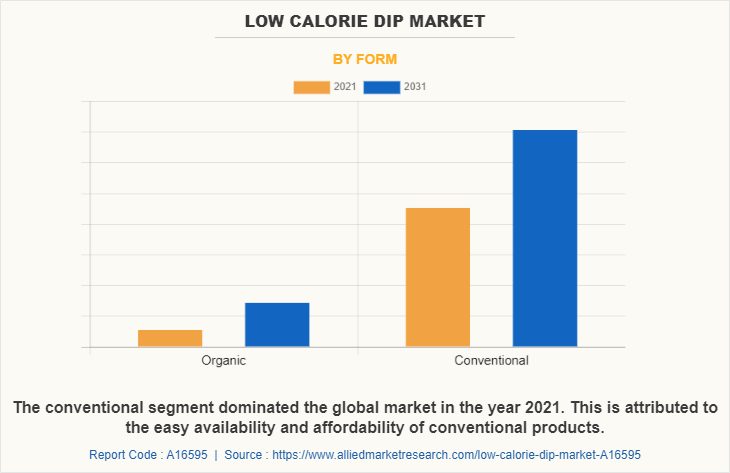
On the basis of form, the market is segmented into organic and conventional. Conventional segment had the dominating Low Calorie Dip Market Size in the year 2021. This is attributed to high demand from food service sector which in general prefer conventional products. The major demand for conventional low calorie dip is from the commercial segment owing to the bulk requirement. However, organic segment was the fastest growing during the forecast period, One of the leading growth factors of organic low calorie dip is the rise in consumer preference toward organic products as these products are free from harmful chemicals and pesticides. In addition, consumer increased concern toward environmental sustainability also plays a key role for the adoption of organic products. Organic farming is good for the environment as it reduces pollution, conserves water, reduces soil erosion, increases soil fertility, and consumes less energy.
Furthermore, expansion of hospitality industry has created new growth avenues for this segment across the regions. Nevertheless, the conventional segment faces stiff competition from organic variant but has upper hand in the market owing to its competitive prices and easy availability. Furthermore, conventional low calorie dip is widely preferred across various industries such as food & beverages, cosmetic & personal care, and confectionery. These aforementioned factors are expected to propel the growth of the conventional low calorie dip segment during the Low Calorie Dip Market Forecast period.
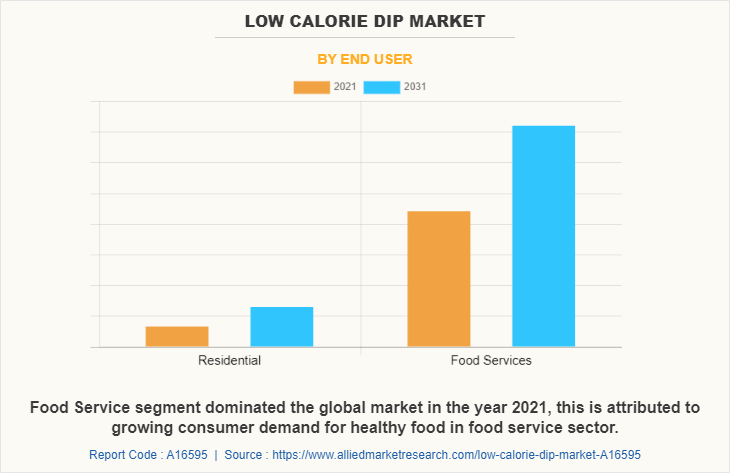
On the basis of end user, residential segment is anticipated to be the fastest growing segment during the forecast period. Low calorie dip in residential applications is not widely used, however, there is an increase in their prevalence in the residential sector. Surge in the penetration of organic products have significantly contributed to the growth of the low calorie dip in both the developing as well as developed markets. Furthermore, the rise in consumer awareness toward the low calorie dip, extensive marketing and advertising by leading brands, and shift in consumer preference for low calorie dip have boosted the demand from the household segment. However, food service segment dominated the global market in the year 2021. Sauces and dressings provide a lot of flavors, whether they are used on meat, salads, or sandwiches. Dips and spreads, on the other hand, are giving these more traditional mealtime condiments a run for their money. Millennials and other young consumers prefer the active nature of dipping and spreading to having their food pre-slathered and seasoned when it comes to snacks. Nowadays, instead of a salad tossed in dressing, vegetables are replacing lettuce and other greens, and spreads are replacing dressings. There is simply more consumer involvement when something is spread or dipped rather than eaten whole with a fork and knife.
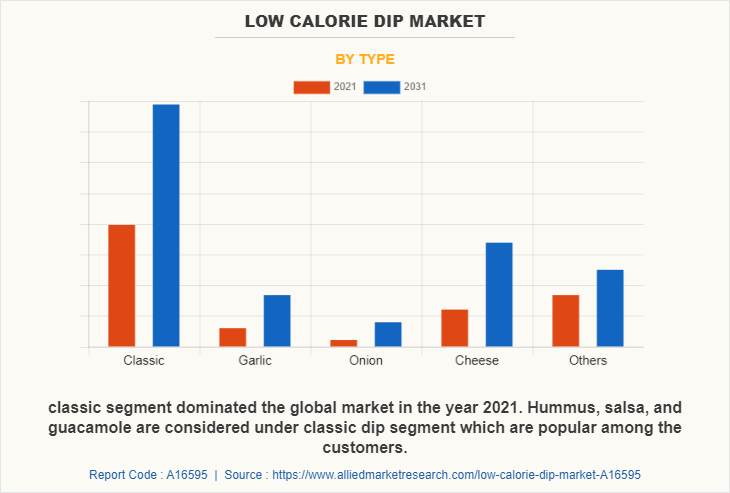
On the basis of type, classic dip segment dominated the global market in the year 2021. This is attributed to high consumer preference towards classic dips due to their enriched flavors. It is a spread or dip cooked with lime, onion, chili pepper, garlic, tomato, and seasonings like salt and black pepper, guacamole is a rich and creamy avocado-based dish. It enhances heart health, prevents stroke, lessens liver damage, and fights inflammation. It also helps the brain and liver operate better. It also helps to reduce deeper visceral belly fat and keep a person satisfied until their next meal by encouraging satiety. Regular, moderate use of it prevents bloating, moisturizes the skin, and delays ageing. As a result, it is frequently used as a salad element and condiment in many different cuisines in the food and beverage (F&B) business. However, cheese dip segment will be the fastest growing segment during the forecast period. American consumers are becoming infatuated with cheese sauces and spreads, if restaurant menus and new product introductions are any clue. Cheese sauces continue to draw in increasing numbers of customers, whether they are used in traditional macaroni and cheese dishes, on top of juicy hamburgers, or as a topping for nachos. The consumer preference for cheese and related products is thus high and will rise during the forecast period.
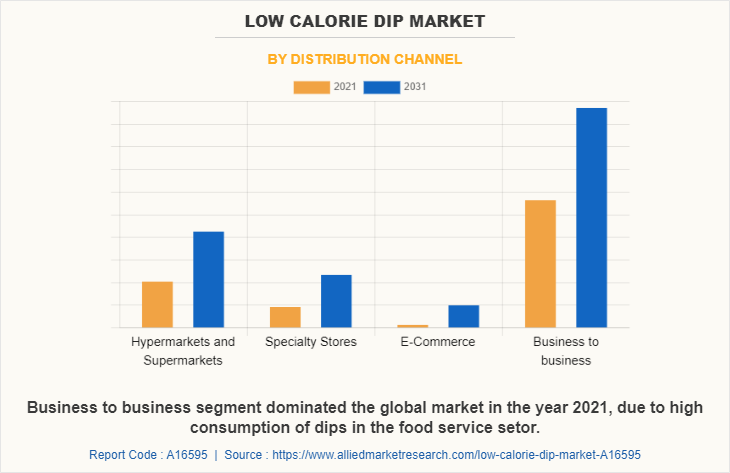
On the basis of distribution channel, business to business segment dominated the global market in the year 2021. However, online sales channel will be the fastest growing segment during the forecast period. Rigorous online marketing has increased the popularity of this distribution channel in recent years, complemented by vast options, availability of detailed information, discount & free home delivery offered by various e-commerce platforms. Moreover, there is a significant growth in the industry in developing economies as a result of increased Internet penetration. As a result, the online sales channel segment is expected to grow at the highest rate during the forecast period and will boost the low calorie dip market.
By Region
North America region dominated the global market in the year 2021, due high consumption of convenience food such as dips & spreads in the region.
On the basis of region, North America dominated the global market in the year 2021. The North America market for low calorie dip is driven by increase in consumption of convenience food such as dips and rise in concerns about health and fitness. Moreover, North America has a developed retail structure that allows the consumers to conveniently purchase food and groceries. This easy availability helps with the overall sale of convenience goods such as the low calorie dip. However, LAMEA will be the fastest growing regionnt during the forecast period. The food & beverage market continues to grow quickly, owing to changes in consumer work and lifestyles, which has encouraged people in the region to start eating out more frequently. Rise in youth population and increase in the awareness about organic farming and the trend of consuming pesticide free food supplements the growth of the low calorie dip market.
The players operating in the global low-calorie dips market have adopted various developmental strategies including but not limited to product launches, geographical expansion, and acquisitions to increase their Low Calorie Dip Market Share, gain profitability, and remain competitive in the market. The key players included in the Low Calorie Dip Market Analysis are - Kite Hill, Earthy Bliss, Focus Brands LLC, The Honest Stand, Pepsico, Inc., Strauss Group inc., Good Karma Foods, Rigoni Di Asiago S.R.L, General Mills, Inc., Good Foods Group, GreenSpace Brands, Winegreens world, Nestle S.A., and PANOS brands.
Key Benefits For Stakeholders
- This report provides a quantitative analysis of the market segments, current Low Calorie Dip Market Trends, estimations, and dynamics of the low calorie dip market analysis from 2021 to 2031 to identify the prevailing low calorie dip market opportunities.
- The market research is offered along with information related to key drivers, restraints, and opportunities.
- Porter's five forces analysis highlights the potency of buyers and suppliers to enable stakeholders make profit-oriented business decisions and strengthen their supplier-buyer network.
- In-depth analysis of the low calorie dip market segmentation assists to determine the prevailing market opportunities.
- Major countries in each region are mapped according to their revenue contribution to the global market.
- Market player positioning facilitates benchmarking and provides a clear understanding of the present position of the market players.
- The report includes the analysis of the regional as well as global low calorie dip market trends, key players, market segments, application areas, and market growth strategies.
Low Calorie Dip Market Report Highlights
| Aspects | Details |
| Market Size By 2031 | USD 424.6 billion |
| Growth Rate | CAGR of 5.5% |
| Forecast period | 2021 - 2031 |
| Report Pages | 335 |
| By Form |
|
| By End User |
|
| By Type |
|
| By Distribution Channel |
|
| By Region |
|
| Key Market Players | Earthy Bliss, The Honest Stand, GreenSpace Brands, Good Foods Group, General Mills, Inc., Good Karma Foods, Kite Hill, Rigoni Di Asiago S.R.L, Strauss Group inc., PANOS brands, Pepsico, Inc., Nestle S.A., Winegreens world, Focus Brands LLC |
Analyst Review
On the basis of the interviews of various top-level CXOs of leading companies, the increase in sale of low calorie dip is driven by changing consumer preference and adoption of organic food consumption trend. The health benefits obtained from low calorie dip are backed by their high antioxidant content, which is also supporting its sale among the consumers. Furthermore, increase in consumption of organic food products has a positive impact on the low calorie dip market.
In the U.S., more than half of consumers will occasionally try new flavors of sauces and dips, and nearly a quarter will go out of their way to try new flavors. This demonstrates that flavor trial is high in this category, indicating that new flavors can be an effective strategy for attracting new U.S. consumers.However, the flavors should not be too dissimilar to those to which consumers are accustomed; 41% of US consumers say they are more interested in trying new flavors that are similar to their favorites. One strategy for addressing this preference is to use flavors that are well-known to consumers but are either new or underrepresented in the sauce aisle, such as bourbon, Thai peanut, ginger sesame, and maple bacon. This encourages consumers to try a new product and experiment with flavors while remaining in familiar territory.
Younger consumers lead in terms of willingness to experiment with flavor. For instance, a much higher percentage of those under 45 want to try flavors and ingredients like peri peri, togarashi, gochujang, chimichurri, and za'atar in a dip or sauce than those 45 and up.
To meet the demand of the consumers and to expand their business, organic products manufacturers across various regions follow the strategy of improvement of their existing products as well as increase in the manufacture of flavored organic dip. This is one of the major factors due to which the demand for low calorie dip is experiencing a surge. U.S. is among the dominating countries holding a major Low Calorie Dip Market Shareand exports the product in various other countries, which include China, Canada, Mexico, the UK, and others.
The global low-calorie dip market was valued at $252,863.2 thousand in 2021 and is projected to reach $424,640.9 thousand by 2031, registering a CAGR of 5.5%.
The Low-Calorie Dip market report includes data from 2021 to 2031 and, from 2022-2031 would be the forecast period in the market report.
$252.8 million is the market value of Low-Calorie Dip market in 2021, registering a CAGR of 5.5%. The growth in employment rate and urbanization is a factor that boosts the market.
North America, Europe, Asia-Pacific and LAMEA a re the regions analyzed iand 2021 is the base year calculated in the Low-Calorie Dip market report.
The top companies hold the market share in Low-Calorie Dip market are Kite Hill, Earthy Bliss, Focus Brands LLC, The Honest Stand, Pepsico, Inc., Strauss Group inc., Good Karma Foods, Rigoni Di Asiago S.R.L, General Mills, Inc.
Loading Table Of Content...


